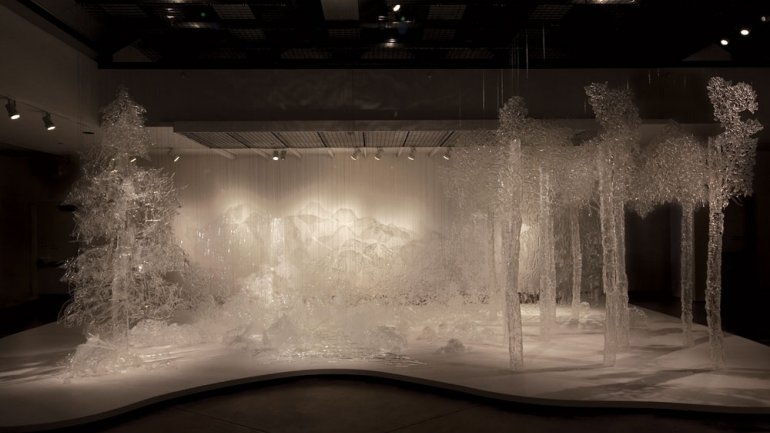Vanishing Point
Vanishing Point
Suzanne Beal steps into "Glimmering Gone: Ingalena Klenell and Beth Lipman," a breathtaking installation at Tacoma, Washington's Museum of Glass, and discovers a potent meditation on longing and loss.
Two glass artists, two countries, an all-but-forgotten Northwest painter, and a multitude of seemingly familiar objects are at the heart of an exhibition that tackles, among other things, longing and loss.
Swedish artist Ingalena Klenell and American artist Beth Lipman met at a teaching session in Coldigioco, Italy, in 2002. "Glimmering Gone," an installation in three parts, is the result of their time spent together and apart. Working on different continents, Lipman, best-known for clear-glass interpretations of still-life paintings, and Klenell, noted for large-scale, kiln-formed installations, sought a common visual vocabulary consisting of utilitarian items, luxury goods, and objects from the natural world.
For two years, they created elements in their respective studios (in Sheboygan Falls, Wisconsin, and Sunne, Sweden) to be reassembled at the Museum of Glass, where, during a two-week residency in January 2010, they and teams of American and Swedish assistants continued to create the more than 400 kiln-formed, blown, sculpted, and cut components. Together they form a world of fragmented beauty.
Mementos, the first part of the exhibition that viewers encounter, is also the least accessible. Everyday objects, replicated in clear glass and truncated, are arranged in seven elaborate configurations suggestive of jewelry cases, held captive behind glass panes: The disembodied head of a shovel, the bristles of a paintbrush, the clasp of a change purse are both there and curiously not there. Viewers must remain hands-off even as the items' implied function begs to be put to use.
In Artifacts, the artists reintroduce a number of the man-made partial objects from Mementos, this time in sandblasted, opaque white glass, casting shadows and seeming to sink into the surface of a plain white wall. The glittering promise of the new, as observed in Mementos, has been usurped by the daily grind.
Klenell's skill with architectural installations and Lipman's with still-life compositions find full expression in Landscape, a dazzling floor-to-ceiling sculpture composed of visually layered sheets of slumped and fused plate glass and crystalline masses. If the composite utopia of Landscape grants infinite visual pleasure, it rejects any notion of entry. The foot that treads upon the fragile - albeit gorgeous - illusion of frozen trees, mountains, clouds, and mist is destined to shatter it. At the heart of Landscape is an acknowledgment of the gap between the reality of an object and the desire for it, and perhaps more important, an un-spoken warning to be careful what you wish for.
The artists' ideas about the environment - both natural and man-made - are mirrored in the work of Washington painter Abby Williams Hill (1861-1943), whom they studied during their stay in the Northwest.
Hill skillfully translated her enthusiasm for the outdoors into painted landscapes, which the Great Northern Railway notably used to promote state tourism and business. In Hill's hands, landscape became the ultimate consumer commodity. Effectively luring trainloads of visitors into the splendor she captured on canvas, she inadvertently hastened the demise of the sites immortalized in her paintings.
Visitors who beat a path to the Museum of Glass to camp out with "Glimmering Gone" and the objects that inhabit it won't leave ruin in their wake. How could they? Suspended between the real world and wishful thinking, "Glimmering Gone" only suggests a captured moment in time, and as Lipman says, it could be "a moment you never had to begin with."
Suzanne Beal is a writer in Seattle.

